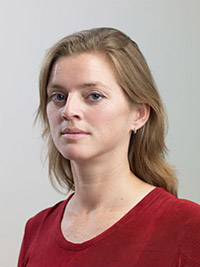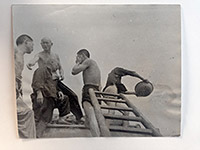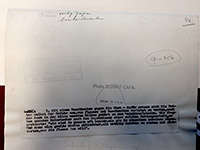Photo Collection Research Tutorial
Maartje van den Heuvel, researcher and curator of photography at Leiden University, will be giving a tutorial next semester to master students of Film & Photographic Studies. A great opportunity for them to work with an exceptional collection from the Leiden University Library. Van den Heuvel explains her vision.
What exactly are the tutorials about?
 My tutorial Photo Collection Research is about the material side of photography. Besides the flighty and ‘fast’ digital or reproduced photography, there is a world of photography to be found in the ‘slow,’ solid, material form. This tangible matter requires its own knowledge and norms and also has its own laws, rules and customs. The kinds of questions that arise during photo collection research are numerous.
My tutorial Photo Collection Research is about the material side of photography. Besides the flighty and ‘fast’ digital or reproduced photography, there is a world of photography to be found in the ‘slow,’ solid, material form. This tangible matter requires its own knowledge and norms and also has its own laws, rules and customs. The kinds of questions that arise during photo collection research are numerous.
Why are we attached to an old, faded photograph of a loved one in a beautifully decorated frame? Why did a print by Andreas Gursky fetch over four million dollars not long ago? What information can be obtained from an original print by Robert Capa? What can be learned from the historically established photography collection of a museum or from the original negatives in a photographic archive?
What do you want to contribute, with this tutorial, to the curriculum of Film & Photographic Studies?

During Photo Collection Research students will acquire hands-on knowledge and experience in working with original photography and collections. Leiden University is home to the oldest museological photo collection in The Netherlands. The collection is, in many respects, more interesting than that of the well-known museums of photography. You will need to learn how to handle original ‘vintage prints’ if you want to work for museums, galleries or archives, or if you want to curate other kinds of exhibitions. Opportunities to gain experience in this field, however, are rare – a complaint I hear from colleagues worldwide. Leiden University does offer this opportunity, as one of the few universities in the world.
Is the tutorial only intended for students of Film & Photographic Studies?

Photo Collection Research is open to students of different disciplines. Besides students from Film & Photographic Studies, the tutorial could be of interest to students of Art History who aspire to work with photography in museums. For students of Media Technology, this tutorial could be a valuable addition to their study program because they will get the opportunity to study and work with the material aspects of media images. Students of History, Visual Anthropology or Communication Studies will learn how to work with original photography and archives as visual sources of information.
When will the tutorial be judged a success? What is your goal?
Hopefully, at the end of the semester, students will have acquired unique knowledge and experience in working with original photographs, objects and archives. They will have learned a lot about the various material forms that photography has adopted since its invention in 1839. They will have learned about the handling of original material and will know what terms such as 'original', 'reproduction', 'artists' copy' and 'vintage print' mean in the context of photography. They will understand the added value of tangible material images in comparison with reproductions: digital or by other means. They will also know what specific knowledge can be gained from studying the relationship between related images in a collection or archive.
Your dissertation is also about photography, landscape photography to be exact. What fascinates you about this subject? Will you be discussing it during the tutorial?
Everyone has strong feelings about the nature or landscape that surrounds him or her, especially, since environmental issues have recently been put high on the agenda. After the ecological crisis of the seventies, people have sought a renewed contact with nature. This desire for contact is reflected in contemporary photography. It is interesting to see how photographers like Hans Aarsman and Wout Berger in the eighties, and more recently, Gerco de Ruijter, Ellen Kooi and Mischa de Ridder, are well aware of early traditions in landscape painting. Through their choice of materials and the size of their images, they give contemporary interpretations of traditional concepts that reflect the way in which we view historical art and our changing environment. Depending on the number of applicants, students might study works for an upcoming exhibition that will take place in 2016. However, I also think there is a very intriguing and recent case in which a study of the composition of a photographic archive is central to a well-known judicial process: the photography of the Tuol Sleng prison in Phnom Penh, Cambodia from 1975-1979. Those who want to learn more about museum collections can take on a new acquisition or research an unknown family album from the nineteenth century. Options aplenty!
